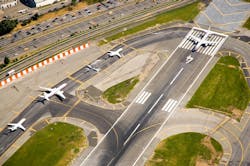Honeywell demonstrates SURF-A runway incursion avoidance tech
PHOENIX - When an aircraft is someplace it isn't supposed to be, it often results in a potentially dangerous situation, putting the lives of the flight crew and passengers at risk. These run the gamut from incursions when an aircraft doesn't have permission to be on the runway because another one is already there, excursions—or runway overruns—and wrong-surface events, such as an aircraft landing on the wrong runway or on a taxiway by mistake, Meg Godlewski writes for Flying. Continue reading original article.
The Military & Aerospace Electronics take:
12 June 2024 -“SURF-A will improve flight crew situational awareness and reduce the risk associated with runway incursions, which are happening more frequently as flight hours increase and airports get busier,” said Feyereisen, who is a senior technical fellow at Honeywell Aerospace Technologies."
“SmartRunway and SmartLanding set the standard for current-generation runway safety technology,” said Priyamvada Poyil, Director of Aerospace Offering Management for Honeywell’s EGPWS and traffic computer product line. “They are installed on about 5,000 commercial aircraft, which is around 20% of the world’s fleet. We regularly hear stories from airlines and pilots about how the software helped them avoid runway incursions, over-runs, and wrong-surface landings. We know that SmartRunway and SmartLanding are preventing accidents and saving lives.”
The Honeywell demonstration scenario drew from a real incident at Austin-Bergrstrom International in 2023. In this incident, air traffic control cleared a FedEx 767-300 freighter to land on Runway 18L, which was occupied by a Southwest Airlines 737. The investigation found that the 737, while still taxiing toward the runway, requested takeoff clearance. The controller mistakenly believed the 737 was already at the runway threshold and issued the clearance. At that moment, the 767 was less than a mile from the runway. The 737 crew then paused for 19 seconds on the runway to run up the engines for deicing procedures before beginning their takeoff roll.
Related: NOAA taps Honeywell to deploy new weather observation technology
Related: Honeywell introduces AI software solution for commercial MRO
Related: Lilium selects Honeywell to develop propulsion unit position sensors for its flagship eVTOL
Jamie Whitney, Senior Editor
Military + Aerospace Electronics
